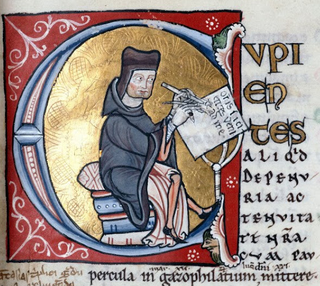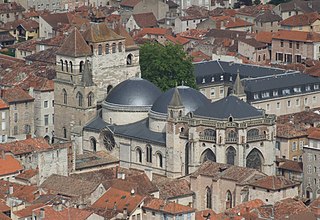
Maurice de Sully (died 11 September 1196) was Bishop of Paris from 1160 until his retirement in 1196. He was responsible for the construction of the Cathedral of Notre-Dame.

Maurice de Sully (died 11 September 1196) was Bishop of Paris from 1160 until his retirement in 1196. He was responsible for the construction of the Cathedral of Notre-Dame.
He was born to poor parents at Sully-sur-Loire (Soliacum), near Orléans, at the beginning of the twelfth century. He came to Paris towards 1140 and studied for the ecclesiastical state. He soon became known as an able professor of theology and an eloquent preacher. It has been frequently asserted, but without sufficient proof, that he was a canon of Bourges. In 1159, he was mentioned as the Archdeacon of Paris, and on 12 October 1160, largely through the influence of Louis VII, he was elected to succeed Peter Lombard in the episcopal see of that city.
The present Cathedral of Notre-Dame stands as a monument to his episcopal administration. Its construction was begun and almost entirely completed under him. In 1163, Pope Alexander III laid the cornerstone of the magnificent edifice, and in 1185 the Patriarch of Jerusalem, Heraclius, officiated in the completed sanctuary. He also converted the synagogue that stood on the site of the now Église de la Madeleine when it was seized by Philip II of France from the Jews of Paris in 1182, and duly consecrated it as a church dedicated to Mary Magdalene. Maurice de Sully also rebuilt the episcopal palace in which the nobility and clergy met in 1179 at the coronation of Philip Augustus as joint ruler with his father Louis VII. He enjoyed in a high degree the confidence of both rulers, accompanied Louis to his meeting with Frederick Barbarossa at Saint-Jean-de-Losne in 1162, and was one of the guardians of the royal treasury during the Third Crusade (1190). [1]
In the controversy between Thomas Becket and Henry II of England, he energetically defended the former and, in three letters still extant, pleaded his cause with Alexander III. He forbade the celebration of the feast of the Immaculate Conception in his diocese, but is said to have strongly supported by appeals to the Bible (Job, xix, 25-27) the doctrine of the resurrection of bodies, against some sceptical noblemen. Although he retained the administration of his diocese, he retired, late in life, to the Abbey of Saint Victor, Paris, where he died.
Maurice de Sully is the author of a treatise on the Canon of the Mass, preserved in manuscript at Bourges. Numerous sermons, some in Latin, others in vernacular, are also attributed to him. Those written in the Latin tongue were not directly destined for the people, but rather for the use and study of the clergy. The French sermons do not seem to be in their present form the original work of Maurice de Sully; they are more commonly considered as reproductions made by ecclesiastics from his Latin collection. No critical edition of these sermons has yet been published; his three letters to Alexander III are printed in P. L., CC, 1419–22, as are also some of his official documents (CCV, 897-914). [1]

Peter Lombard was an Italian scholastic theologian, Bishop of Paris, and author of Four Books of Sentences which became the standard textbook of theology, for which he earned the accolade Magister Sententiarum.

The Archdiocese of Paris is a Latin Church ecclesiastical jurisdiction or archdiocese of the Catholic Church in France. It is one of twenty-three archdioceses in France. The original diocese is traditionally thought to have been created in the 3rd century by St. Denis and corresponded with the Civitas Parisiorum; it was elevated to an archdiocese on October 20, 1622. Before that date the bishops were suffragan to the archbishops of Sens.

The Archdiocese of Reims is a Latin Church ecclesiastic territory or archdiocese of the Catholic Church in France. Erected as a diocese around 250 by St. Sixtus of Reims, the diocese was elevated to an archdiocese around 750. The archbishop received the title "primate of Gallia Belgica" in 1089.

The Diocese of Beauvais, Noyon, and Senlis is a Latin Church ecclesiastical territory or diocese of the Catholic Church in France. The diocese encompasses the department of Oise in the region of Hauts-de-France. The diocese is a suffragan of the metropolitan Archdiocese of Reims. The current bishop is Jacques Benoit-Gonnin, appointed in 2010.

The Diocese of Meaux is a Latin diocese of the Catholic Church in France. The diocese comprises the entire department of Seine-et-Marne. It was suffragan of the Archdiocese of Sens until 1622, and subsequently of Archdiocese of Paris.

The Archdiocese of Bordeaux (–Bazas) is a Latin Church ecclesiastical territory or archdiocese of the Catholic Church in France. The episcopal see is Bordeaux, Aquitaine. It was established under the Concordat of 1802 by combining the ancient Diocese of Bordeaux with the greater part of the suppressed Diocese of Bazas. The Archdiocese of Bordeaux is a metropolitan see, with four suffragan dioceses in its ecclesiastical province: Dioceses of Agen, Aire and Dax, Bayonne, and Périgueux.

The Diocese of Digne is a Latin Church ecclesiastical territory or diocese of the Catholic Church in France. Erected in the 4th century as the Diocese of Digne, the diocese has been known as the Diocese of Digne–Riez–Sisteron since 1922. The diocese comprises the entire department of Alpes-de-Haute-Provence, in the Region of Provence-Alpes-Côte d'Azur. The diocese was a suffragan diocese of the Archdiocese of Aix-en-Provence and Arles until 2002 and is now a suffragan diocese in the ecclesiastical province of the metropolitan Archdiocese of Marseille. The Bishop of Digne's cathedra is found in Digne Cathedral at the episcopal see of Digne-les-Bains.

The Diocese of Tulle is a Latin Church diocese of the Catholic Church in Tulle, France. The diocese of Tulle comprises the whole département of Corrèze.

The Diocese of Troyes is a Latin Church ecclesiastical territory or diocese of the Catholic Church in Troyes, France. The diocese now comprises the département of Aube. Erected in the 4th century, the diocese is currently a suffragan diocese in the ecclesiastical province of the metropolitan Archdiocese of Reims. It was re-established in 1802 as a suffragan of the Archbishopric of Paris, when it comprised the départements of Aube and Yonne and its bishop had the titles of Troyes, Auxerre, and Châlons-sur-Marne. In 1822, the See of Châlons was created and the Bishop of Troyes lost that title. When Sens was made an archdiocese, the episcopal title of Auxerre went to it and Troyes lost also the département of Yonne, which became the Archdiocese of Sens. The Diocese of Troyes covers, besides the ancient diocesan limits, 116 parishes of the ancient Diocese of Langres and 20 belonging to the ancient diocese of Sens. On 8 December 2002, the Diocese of Troyes was returned to its ancient metropolitan, the Archbishop of Reims. As of 2014, there was one priest for every 2,710 Catholics.

The Diocese of Saint-Flour is a Latin diocese of the Catholic Church in France. The diocese comprises the department of Cantal. Erected in 1317, the diocese was suffragan of the Archdiocese of Bourges until 2002. With the general reorganization of the structure of the French church by Pope John Paul II, Saint-Flour became the suffragan of the Archdiocese of Clermont. The seat of the bishop is located in Saint-Flour, Cantal.

The Diocese of Amiens is a Latin Church diocese of the Catholic Church in France. The diocese comprises the department of Somme, of which the city of Amiens is the capital.

The Diocese of Cahors is a Latin Church diocese of the Catholic Church in France. The diocese comprises the whole of the department of Lot.

Jean-Baptiste Count de Belloy was an Archbishop of Paris and cardinal of the Catholic Church.

The Diocese of Nancy and Toul is a Latin Church ecclesiastical territory or diocese of the Catholic Church in France. After a considerable political struggle between Louis XV, Louis XVI, and the Dukes of Lorraine, the diocese was erected by Pope Pius VI on 17 December 1777. The Diocese of Nancy is a suffragan diocese in the ecclesiastical province of the metropolitan Archdiocese of Besançon.

The Diocese of Le Puy-en-Velay is a Latin diocese of the Catholic Church in France. The diocese comprises the whole Department of Haute-Loire, in the Region of Auvergne-Rhône-Alpes. Currently the diocese is a suffragan of the Archdiocese of Clermont. Last bishop, as of April 2015 was bishop Luc Crépy. Actually is bishop in Versailles, Since February 2021. The current bishop, as of March 2022 is Yves Baumgarten.

The Diocese of Luçon is a Latin Church diocese of the Catholic Church in France. Its see is Luçon Cathedral in the commune of Luçon. The diocese comprises the department of Vendée. Created in 1317 out of the diocese of Poitiers, its existence was interrupted during the French Revolution, but it was restored in 1821, along with the Bourbon restoration.

The Diocese of Mende is a Latin diocese of the Catholic Church in France. The diocese covers the department of Lozère.

The Diocese of Moulins is a Latin diocese of the Catholic Church in France. The episcopal see is located in the city of Moulins. The diocese comprises all of the department of Allier in the region of Auvergne.

The Diocese of Nevers is a Latin Church diocese of the Catholic Church in France. The diocese comprises the department of Nièvre, in the Region of Bourgogne.

The Diocese of Pamiers, Couserans, and Mirepoix is a Latin Church diocese of the Catholic Church in southern France. The diocese comprises the department of Ariège and is suffragan to the Archdiocese of Toulouse. The diocese of Pamiers is divided into five Deaneries: Pamiers, Foix, Haut-Ariège, Couserans, and Pays-d'Olmes-Mirapoix. The episcopal see is the Cathedral of Saint Antoninus in the city of Pamiers.
![]() This article incorporates text from a publication now in the public domain : Weber, Nicholas Aloysius (1913). "Maurice de Sully". In Herbermann, Charles (ed.). Catholic Encyclopedia . New York: Robert Appleton Company.
This article incorporates text from a publication now in the public domain : Weber, Nicholas Aloysius (1913). "Maurice de Sully". In Herbermann, Charles (ed.). Catholic Encyclopedia . New York: Robert Appleton Company.